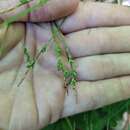Comprehensive Description
provided by North American Flora
Carex communis L. H. Bailey, Mem. Torrey Club 1 : 41. 1889
"Carex varia Muhl." Dewey, Am. Jour. Sci. H: 162. 1826.
Carex varia var. pedicellata Dewey, Am. Jour. Sci. 11: 163. 1826. (Type from western Massachusetts.)
Carex pennsylvanica var. Mithlenhergii A. Gray (N. Am. Gram. 163. 1835); Torr. Ann. Lye. N. Y. 3:410. 1836. (As to plant described only.)
"Carex pennsylvanica Lara." Torr. Ann. Lye. N. Y. 3: 410. 1836.
Carex varia var. minor Boott. 111. Carex 97. pi. 289. 1860. (Based on C. varia Muhl.)
Carex communis var. U'heeleri L. H. Bailey, Mem. Torrey Club 1: 41. 1889. (Type from Ionia County, Michigan.)
Carex pennsylvanica var. nebulosa Barratt; L. H. Bailey, Mem. Torrey Club 1 : 77, as synonym. 1889. (Type from Connecticut.)
Carex pedicellata Britton; L. H. Bailey. Mem. Torrey Club 5: 87. 1894. (Based on C. varia var. pedicellata Dewey.)
Carex pedicellata var. Wheeleri Britton; L. H. Bailey, Mem. Torrey Club 5: 88. 1894. (Based on C communis var. Wheeleri L. H. Bailey.)
"Carex pilulifera L." Fernald, Proc. Am. Acad. 37: 503. 1902.
"Carex pilulifera var. longibracteala Lange" Fernald, Proc. Am. Acad. 37: 504. 1902.
Carex communis var. gynandra Farwell, Am. Midi. Nat. 12:52. 1930. (Type from Livonia, Michigan.)
Loosely cespitose, without long horizontal stolons, but with short, ascending, branching, scaly, reddish-purple rootstocks; culms 1.5-5 dm. high, slender and rather weak, rarely very short, mostly lateral and aphyllopodic, but the terminal central and phyllopodic, sharply triangular and very rough on the angles above, from much shorter than to e.xceeded by the leaves, strongly purplish-red and not conspicuously fibrillose at base, the dried-up leaves of the previous year conspicuous; sterile shoots numerous, strongly aphyllopodic; leaves with well developed blades several to each fertile culm, near the base, the blades light-green, flat, thin, and rather flaccid, 2-5 cm. long, 2-4 mm. wide, rough especially towards the short-acuminate apex and on the margins, the sheaths concave at mouth, the lower breaking and becoming filamentose, the ligule longer than wide, conspicuous, blades of sterile shoots and old leaf-blades 2.5-4 mm. wide, from very short to 3 dm. long, staminate spike solitary, linear, from sessile to noticeably peduncled, 4-18 mm. long, 0.75-2 mm. wide, the scales obovate-oblong, obtuse to acute, the margins white-hyaline, the 3-nerved center green or straw-colored and the intermediate portion reddish-brown; pistillate spikes 2 or 3, the upper one or two approximate and sessile or nearly so, the lowermost somewhat separate and short-peduncled, none basal, the spikes oblong-orbicular, 4-8 mm. long, 3-5 mm. wide, rather closely flowered and usually containing 3-10 ascending perigynia in several rows; lowest bract squamiform or leaflet-like, sheathless or nearly so, usually well -developed and from shorter than to exceeding the inflorescence, narrowly hyaline-margined and purplish-tinged at base; upper bracts much reduced or scale-like; scales ovate to ovate-lanceolate, acuminate to obtuse, exceeded by or somewhat exceeding perigynia, reddish-purple with 3-nerved green center and narrowly hyaline margins; perigynia obovoid, 3-3.5 mm. long, the body puberulent, 2-keeled, but otherwise nerveless, membranaceous, light-green, closely enveloping the achene, obtusely triangular in crosssection, 2 mm. long, 1.5 mm. wide, the body very short-oval or suborbicular, stipitate, abruptly contracted into a spongybase 0.75 mm. long and into a flattish bidentate beak 0.5 mm. long; achenes broadly obovoid, triangular with convex sides, light-brown with lighter angles, minutely pitted, 1.5-2 mm. long, 1.25 mm. wide, short-tapering at base, truncate and short-bentapiculate at apex; style slender, jointed with achene, deciduous; stigmas three, reddish-brown, slender.
T^TE locality; Sarlwell lOS, from Penn Yan, New York, is taken as the type.
Distribution: Dry woodlands, usually on rocky ledges. Nova Scotia to Minnesota, and southward to Georgia, Kentucky, and Arkansas. (Specimens examined from Quebec, Nova Scotia, Prince Edward Island. New Brunswick, Maine, New Hampshire. Vermont, Massachusetts. Rhode Island, Connecticut, New York, New Jersey, Pennsylvania, Delaware, Maryland, West Virginia, District of Columbia. Virginia. North Carolina. South Carolina, Georgia, Ontario, Ohio, Michigan, Minnesota, Indiana, Kentuckv, Iowa, Arkansas.)
- bibliographic citation
- Kenneth Kent Mackenzie. 1935. (POALES); CYPERACEAE; CARICEAE. North American flora. vol 18(4). New York Botanical Garden, New York, NY

